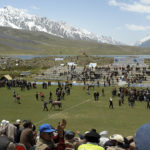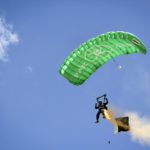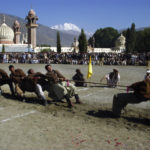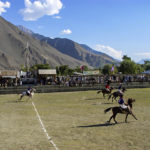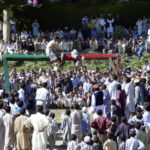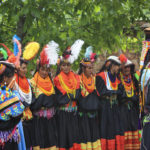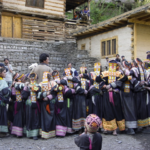FESTIVALS
JULY - THE SHANDUR FESTIVAL
The remote wind-swept amphitheater of the Shandur Pass, located on the lofty border between Gilgit and Chitral, comes to life once a year as the dramatic venue of the Shandur Polo Festival. At 3734m, this is the world's highest polo field, set in a magnificent landscape of rolling pastures, crystalline azure lakes & Hindu-Raj mountains, it is just the setting for the clash of the local polo titans, Chitral and Gilgit. This contest is considered the toughest polo tournament in the world - with fraying tempers and passions running high, the strain of the high altitude and the ferocity of the game create a drama in which horses die and players invariably suffer grievous injuries. Yet despite the hazards, the polo tradition continues unabated. Historically the game goes back many centuries when the local Mehtars, were patrons of polo and it was played, not only for pleasure, but for celebratory and commemorative occasions.
Polo here is not the “Game of Kings” for it is played by ordinary village folk whose keenness for the sport far outweighs their economic capacity to maintain horses and equipment. The children play a type of dismounted polo from the age of four upwards until they become the proud possessor of a pony,it is the local obsession along with music & dancing . In recent years, the event has become something of a legend - the dramatic landscape, the local colour, the presence of international celebrities but above all the passion with which the game is played by the age-old rivals, make the Shandur Polo Festival an unforgettable occasion.
SEPT 15 to 22- THE JASHAN-E-CHITRAL FESTIVAL
The Jashan I Chitral is a traditional festival held in mid September. The people of Chitral have been noted for their love of sports and music for a long time. The ex-state of Chitral encouraged Jashan i Chitral and other cultural activities. Besides traditional sports music and polo were events where teams from different administrative units took part. The winning teams in all events were honoured with privileges. The Jashan was given large publicity and provided an opportunity for the different communities to come closer to each other. In the Jashan various indigenous events are arranged such as poetry, sitar and music, archery , Tug of war, Polo, Buz Kashi, Long distance running , shot puts , weight lifting, wrestling on ground or over pit/ pools , Swimming in the river, etc.
Visitors to the Jashan witness great enthusiasm and rivalry in the best of spirits, there is a larger element of community involvement and each event becomes more interesting.
This is a time when the crops in the valley are ripening and orchards laden with fruit. To the Chitrali it is a time for tuning in his sitar .
THE KALASH FESTIVALS
MAY 14 to 16 . Chilimjusht Festival .“Joshi /Chilimjusht” the Kalash spring festival, is held in the middle of May lasts for four days. . The spring festival honours the fairies and so safeguards the goats and shepherds before they go to the pastures. Before the festival the women and girls gather from all over the valley and decorate their houses.. The women then sprinkle milk on Godess “ Jestak “ the protector of their children and home. The festival begins at Rumbur where the Shaman ( soothsayer ) and tribal chiefs lead a procession to the “ Malosh altar” , high above Grum, to sacrifice goats to the Gods before the ceremonial dances begin. Tribal chiefs in colourful dresses narrate stories of bygone days and events. Later the festival moves on to Bumboret and ends up at Birir , a few days later.
JUL & AUG Ranat & Uchal festival. Earlier in July it starts as the “ Ranat” with dances held on alternate days performed by the young girls and boys in order to safeguard the maize crop. The Uchal festival in Augusts marking the harvest of wheat and barley and bringing down of cheese from the high summer pastures. It is celebrated in Rumbur and Bumboret .
SEPT 21 Pool festival. This is only held in Birir valley around end of September to celebrate the grape and walnut harvest. Grape being a staple requirement in the Kalash society for making wine are grown on trees in protected sites. The holy tree being the best for such climbers. They are picked through out the valley on a particular day and is an occasion for joy and merry making.. It is also an occasion of the shepherds returning from the high pastures .
DEC 18 Chomos festival. As winter starts around mid December the Chomos festival begins ending on 21 Dec. The festival is observed for the divine, the living and dead relatives, for the crops and the goats to be safeguarded, while the community, the village and the valley are purified prior to the coming year. Sighting a fox is a good omen and great efforts are made in this regard. At dusk torch lit processions are led from all the nearby villages culminating at the “Charsue” which is the main customary dancing place. Most of the festivities are indoors where the local wine is handed around as the dance gathers momentum carries out till late in the night round the bonfire. While the tribal elders sit on hill tops at dawn to watch the rising sun and declare the New Year. Goat sacrifices are then made to the Godess “Jastak” , blood from the animal is sprinkled at the temple Jastak An. This is the time when “Balimine” another great God visits the Kalash valley once a year and sacrifices are made at his “ Malosh. Altar” too.


